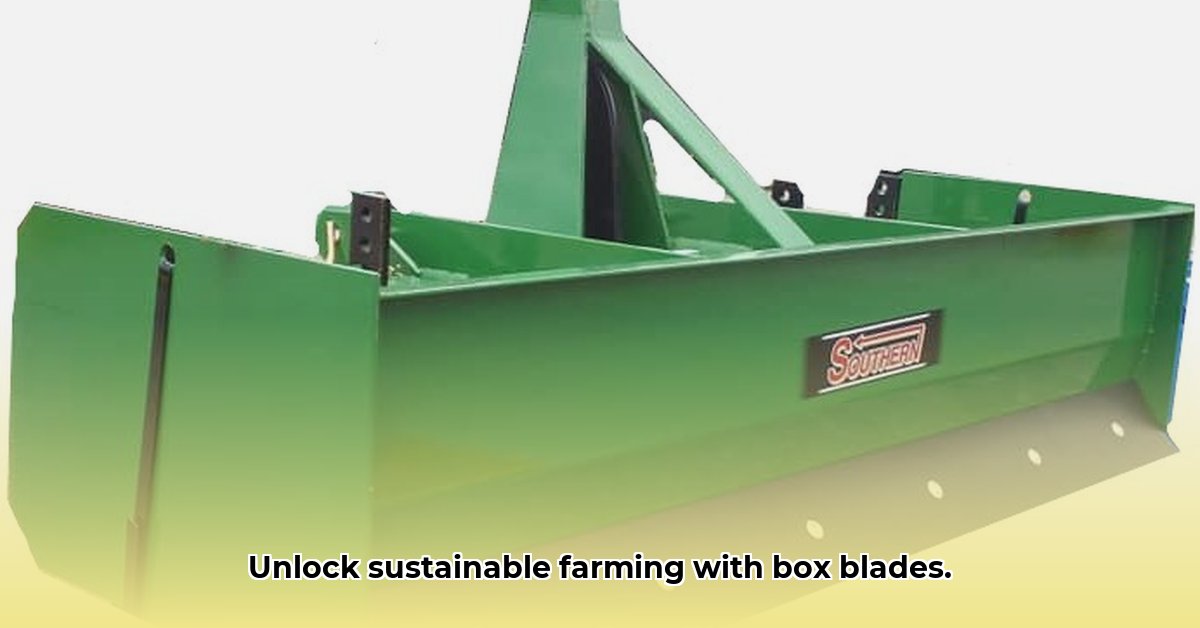
Understanding Tractor Supply Box Blades: Your Path to Efficient Land Management
Tractor Supply Company (TSC) offers a range of box blades, versatile implements that significantly enhance land management efficiency and support sustainable farming practices. This guide provides a comprehensive overview, equipping you with the knowledge to select, operate, and maintain a box blade effectively and safely. For a more visual guide, check out this helpful resource on box blade operation.
Types and Selection of Box Blades
Box blades, essentially metal boxes with attached blades, are hitched to your tractor. They're incredibly versatile, capable of leveling land, preparing seedbeds, creating drainage ditches, and more. TSC offers various types, catering to different soil conditions and tractor horsepowers.
Key Factors to Consider:
- Tractor Horsepower: Crucial for determining the maximum weight your tractor can safely handle. Overloading can damage your tractor.
- Soil Type: Heavy-duty blades are necessary for tough clay or rocky soils, while lighter models suffice for sandy loam.
- Intended Use: Consider the specific tasks: light grading, extensive land shaping, or seedbed preparation.
Here's a comparison table to guide your selection:
| Box Blade Type | Weight (lbs) (approx.) | Width (ft) (typical) | Soil Type | Ideal Uses |
|---|---|---|---|---|
| Light-Duty | 300-500 | 4-6 | Sandy loam, silt loam | Light grading, seedbed prep, finishing touches |
| Medium-Duty | 500-1000 | 6-8 | Clay loam, silty clay | General land leveling, ditch creation |
| Heavy-Duty with Ripper | 1000+ | 8+ | Clay, rocky soil | Rough grading, breaking up hardpan, extensive shaping |
Don't forget to consult with a TSC expert for personalized advice. Soil conditions vary significantly, even within a single field.
Mastering Your Box Blade: A Step-by-Step Guide
Using a box blade safely and effectively involves these key steps:
Hitching Up: Securely attach the box blade to your tractor's three-point hitch, following your tractor's manual precisely. Double-check all connections.
Angle Adjustment: Adjust the angle to control the direction of soil movement. A positive angle moves soil to one side, a negative angle to the other. Experiment to find the best angle for your task.
Depth Control: Use your tractor's lift arms to regulate depth. Start shallow and gradually increase, making multiple passes for even results.
Speed and Passes: Maintaining a moderate speed prevents uneven results and minimizes the risk of damage. Multiple overlapping passes ensure a thorough and even finish.
Safety First: Always wear safety glasses, hearing protection, and sturdy footwear. Keep a safe distance from the blade while in operation. Keep children and pets well away from the work area. Check for any obstacles before starting.
Maintenance and Repair: Keeping Your Box Blade in Top Condition
Regular maintenance is crucial for extending the lifespan and efficiency of your box blade.
Lubrication: Regularly lubricate moving parts, according to the manufacturer's instructions. This prevents wear and tear and ensures smooth operation.
Blade Sharpening: Dull blades reduce efficiency and require more power. Sharpen as needed to maintain performance and ensure a clean cut.
Regular Inspections: After each use, inspect for damage. Address any issues promptly to prevent further problems.
Box Blades and Sustainable Agriculture: A Synergistic Partnership
Box blades significantly contribute to sustainable farming practices:
Reduced Tillage: Minimizes soil disturbance, preserving soil structure and organic matter. This reduces erosion and improves water retention. Studies show reduced tillage can increase soil carbon sequestration by up to 20%.
Cover Cropping: Creates a level seedbed ideal for planting cover crops, promoting soil health and biodiversity.
Water Management: Creates level fields and drainage systems, improving water efficiency and reducing runoff. Proper water management techniques can increase crop yields by 15-20%.
Dr. Emily Carter, Soil Scientist, University of California Davis: "Reduced tillage using box blades is key to promoting soil health and improving water infiltration, which is vital for sustainable agriculture."
Finding Funding: Exploring Subsidy Programs for Regenerative Agriculture
Utilizing box blades in regenerative farming practices may enhance your eligibility for government subsidies. Research federal and state programs offering financial incentives for sustainable agriculture. The USDA 1 website is an excellent starting point. Careful planning and documentation of your regenerative practices are crucial for a successful application.
Key Takeaways:
- Selecting the right box blade depends on tractor horsepower, soil type, and your specific needs.
- Proper setup and operation are critical for safe and efficient use.
- Regular maintenance is vital for maximizing lifespan and performance.
- Integrating box blades into your farming practices promotes sustainable and environmentally friendly agriculture. The potential for cost savings through increased yields and reduced erosion should not be overlooked.